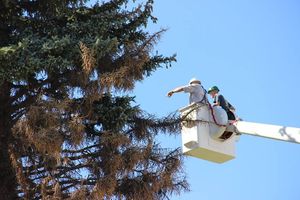Aging Colorado blue spruce assessed during Greener Nebraska Towns event

More than 30 landscape, water, and plant care professionals attended the Greener Nebraska Towns gathering in Chadron recently.
Following the planting of a tree at Kenwood School by Nebraska’s First Lady, Sally Ganem, the group viewed GNT projects at the Dawes County Courthouse and listened to presentations by county commissioner Jake Stewart and Keep Chadron Beautiful director Susan Hucke.
A highlight of the morning came on the CSC Deans Green when 12 tree care professionals assessed two limbs which were removed from the ailing champion Colorado blue spruce and conferred about the tree’s needs.
Mays said, “We will continue to monitor the spruce's health on site and confer with tree care professionals who assessed our tree on event day.”
Rachel Allison with the Nebraska Forest Service, North Platte office, discussed with CSC President Randy Rhine the possible causes of the browning blue spruce. Allison said the purple needles could indicate either over-watering or under-watering.
Other certified arborists on hand speculated that a combination of long-term drought, bacteria, a virus or fungus could be contributing factors to the band of limbs without green needles. The curling limbs could also be a sign that the tree has been seeking more sunlight. Some estimated that problems with the tree could have started many years ago and one noted that it is not a native species.
Amy Seiler, Nebraska Forest Service Community Forestry Specialist from Scottsbluff, said that insects and disease usually are manifest in random areas on the tree instead of a band as seen on the CSC tree.
Other activities included CSC horticulturist Lucinda Mays leading the group on a campus tour of Water Wise projects demonstrating use of drip line irrigation, mulch, and plants chosen for their ability to thrive in the high plains environment.
Stopping north of the CSC student center, the group watched a demonstration by Scott Schremmer, a certified arborist with the City of Chadron.
He air-spaded the root system of a tree using compressed air - a new trend in tree care to aerate compacted soil, move soil away from the tree root zone when trees are planted too deeply, or use as a diagnostic tool to see what is wrong in a tree’s root zone.
Regarding sessions which filled the afternoon, Mays said, "We presented information to other communities about how to manage a GNT grant, proper selection of trees and how to manage water. We’ve learned so many good lessons and were eager to share. I’m proud of all the agencies that came together to make this happen."
Mays and Jane Darnell from the Nebraska Forest Service spoke at the conference about their experience working with the Campus Arboretum Volunteers.
Chadron is one of eight Nebraska communities that received a GNT grant. Other communities involved in the Greener Towns initiative include Scottsbluff, North Platte, Grand Island, Hastings, Lincoln, Bellevue and Fremont.
Local businesswoman and CSC graduate student Lori Frederick wrote the $30,000 matching GNT grant for Chadron tree planting projects. The purpose of the project, which ends this December, is to increase the diversity in the tree canopy within Chadron and a two-mile radius while utilizing sustainable techniques. The matching portion from Chadron State College, Chadron homeowners, residents and volunteers has been provided in time, money and materials.
Mays said, “The GNT committee is very appreciative that Lori took the time to write the grant, get it approved and see that it was well-underway for the first year of the grant. We would not have the grant without her work.”
Justin Evertson, green infrastructure coordinator for the Nebraska Forest Service and the Nebraska Statewide Arboretum, said, “Leaders in Chadron have worked hard on educational outreach and in implementing tree planting and Water Wise landscaping projects. Chadron has proven to be one of the more active and forward thinking communities involved in the initiative and is laying important groundwork for other communities to follow in pursuit of a more sustainable future.”
The Nebraska Forest Service, the Nebraska Statewide Arboretum and the Nebraska Environmental Trust are the three major co-sponsors of the GNT grant.
Category: Campus News




